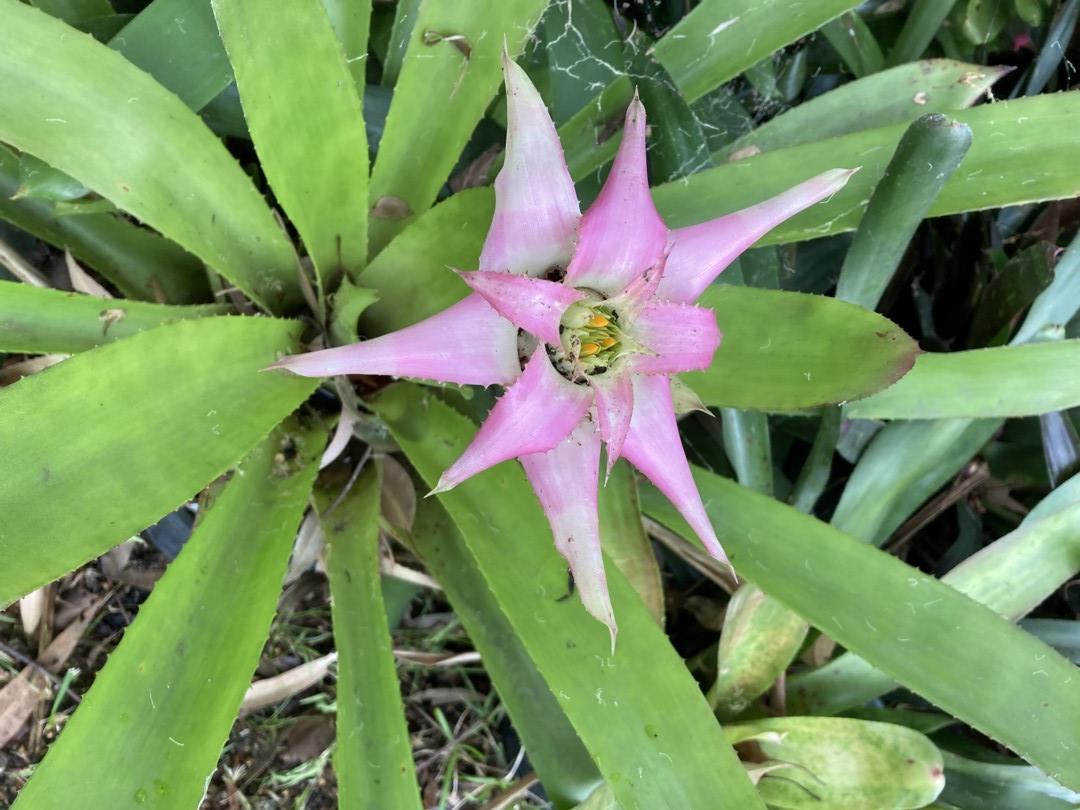
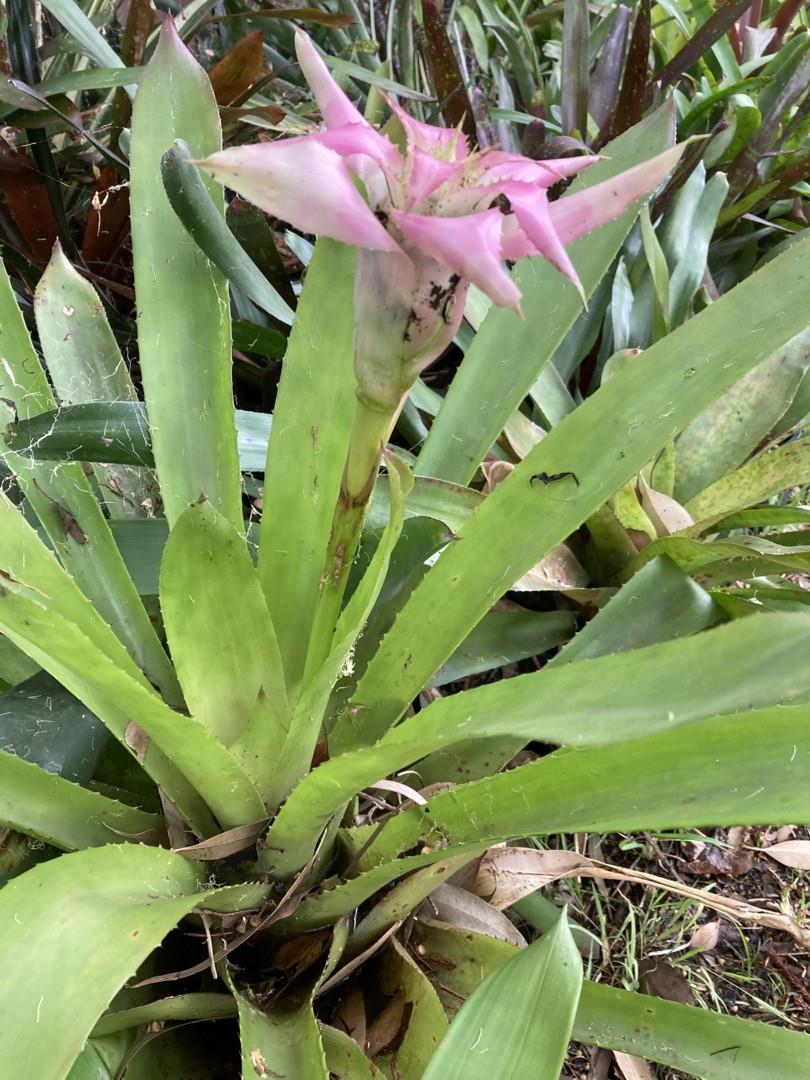
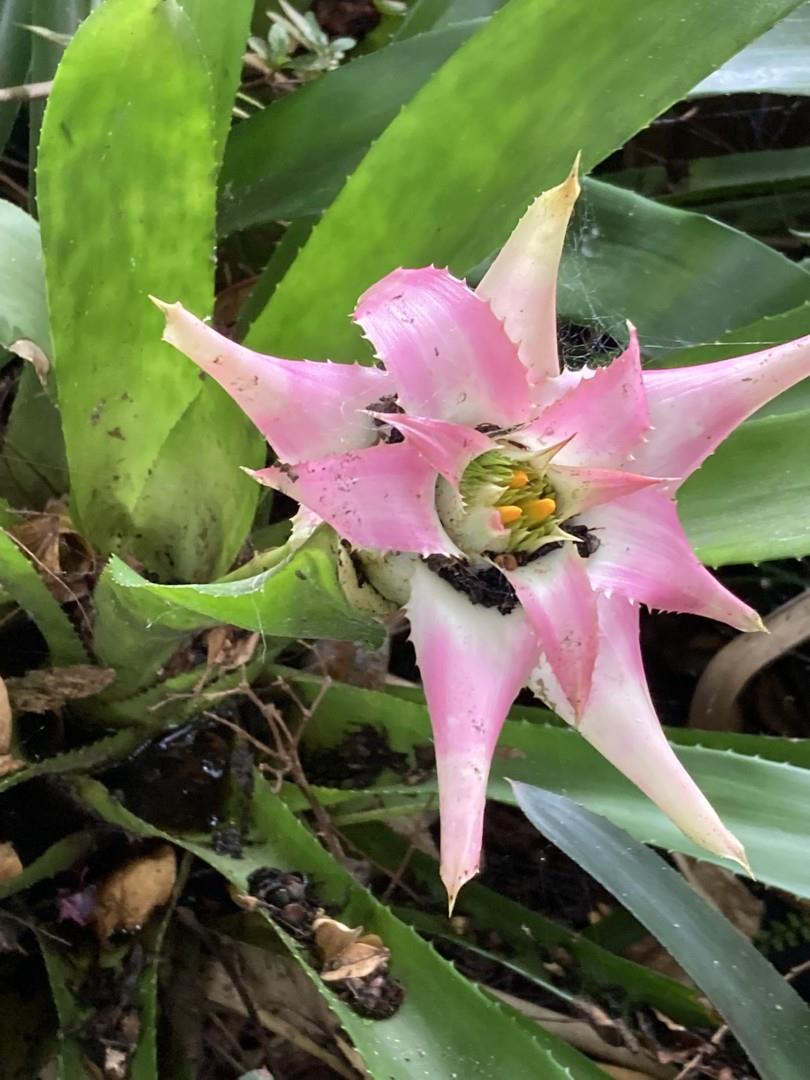
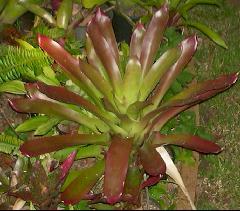
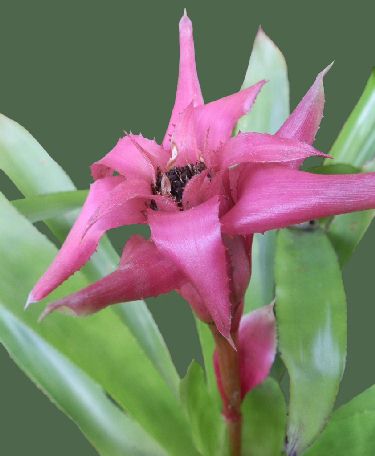
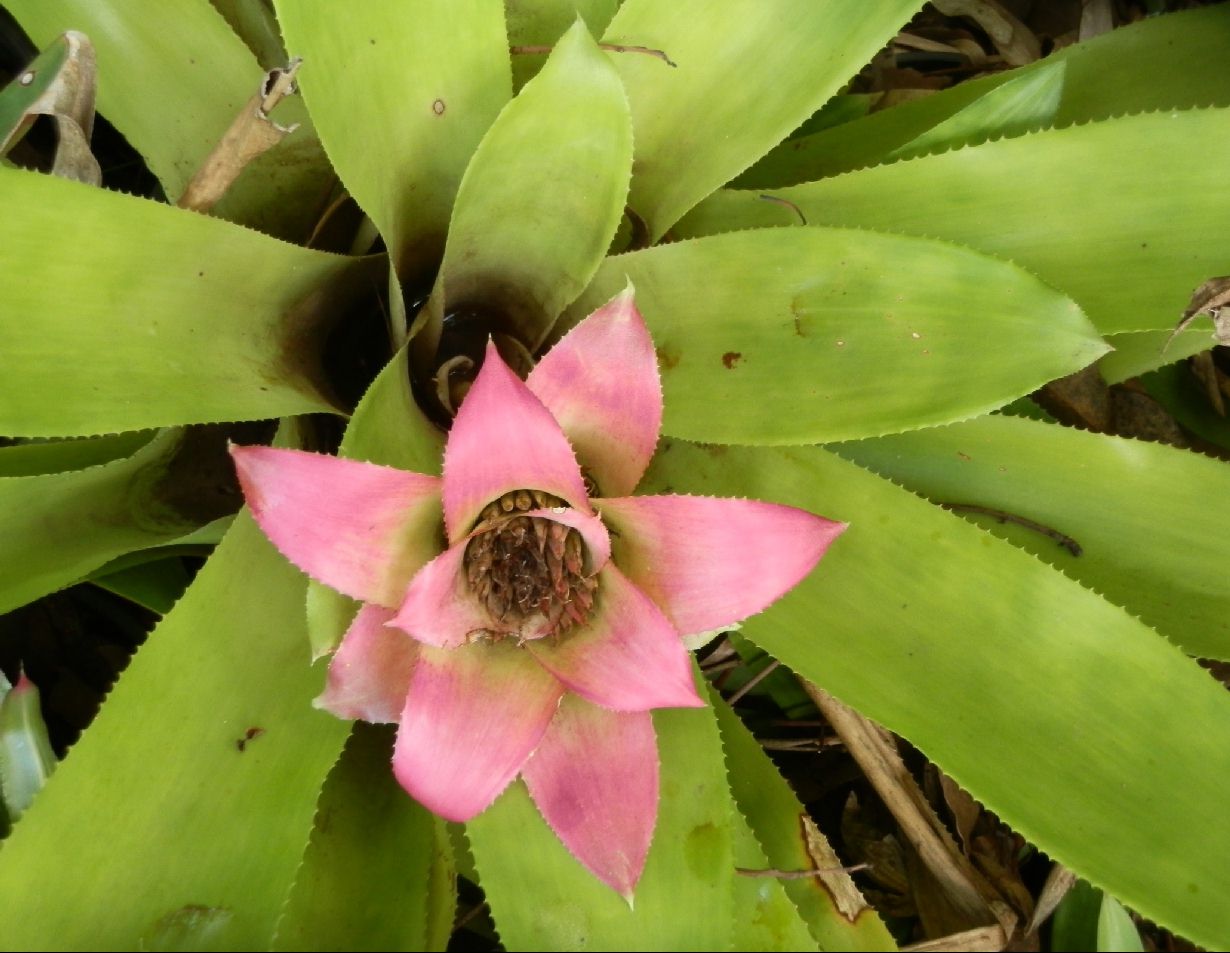
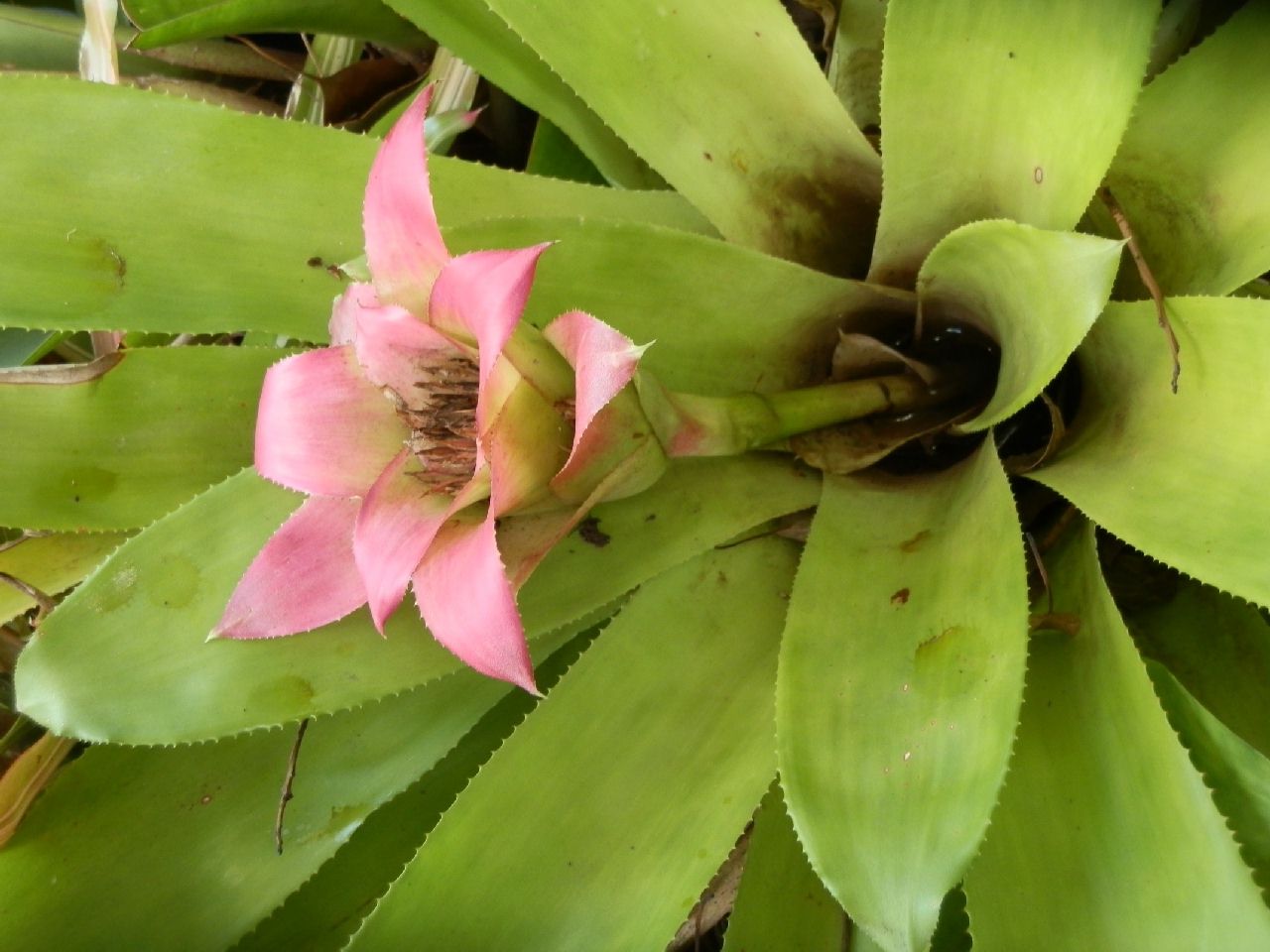
PLANT epiphytic or terrestrial.
LEAVES ca. 20, suberect;
SHEATHS elliptic, ca. 13 x 8 cm, densely brown-lepidote, pale-colored, strongly nervate;
BLADES sublinear, (20-) 30-50 x 5-6 cm, slightly narrowed at base, subdensely and coarsely spinose toward base, spines dark brown, 2-5 mm long, the basal ones retrorse, spinulose toward apex, spines 0.5-1 mm long, glabrescent, green, sometimes with darker green spots, apex acute and apiculate to acuminate, ending in a quite stout rigid spine;
SCAPE 30-55cm long, ca. 1 cm in diameter, soon glabrous, mostly naked;
SCAPE BRACTS one at base and few near the apex, the remaining involucrate.
INFLORESCENCE subumbellate, bipinnate, centrally subsimple, distinctly elevated from the rosette, with a very large subglobose base and a stellate apex of spreading-recurved to strongly reflexed involucral and primary bracts, 7-8 cm long, 8-15 cm in diameter at apex (including the primary bracts), many-flowered;
PRIMARY BRACTS narrowly ovate triangular to narrowly lanceolate, apex acuminate, the outer ones 7-12 x 3.5 cm (the inner ones much reduced), inconspicuously lepidote toward base, reddish-pink at anthesis becoming purplish, subdensely to densely and coarsely serrate with dark brown spines 2-3 mm long, spines gradually reduced and evenly distributed toward apex;
FASCICLES 6 to 8, shortly pedunculate, complanate, the outer ones ca. 5.5 x 3 cm, 5 to 7-flowered, with many sterile floral bracts;
FLORAL BRACTS very narrowly triangular, apex acuminate to a rigid apiculus, ca. 4.5 cm long, ca. 1 cm wide at base, green, carinate, curved, nerved, glabrous, slightly shorter than the sepals, about 2 per flower one being sterile, entire to finely spinulose.
FLOWERS 55-60 mm long, sessile, odorless;
SEPALS subsymmetrical, narrowly lanceolate, apex long acuminate-attenuate, ca. 30 x 6 mm, free, green, glabrous;
PETALS narrowly obovate, apex broadly subacute, ca. 43 x 11 mm, suberect, free, the apical 1/3 golden-yellow, the basal 2/3 white, bearing two ca. 5 x 2 mm, oblong appendages at basc with truncate, irregularly denticulate apex, without callosities;
FILAMENTS free;
ANTHERS ca. 9 mm long, apex apiculate;
STIGMA subglobose, golden-yellow, margins denticulate;
OVARY trigonous, subclavate, ca. 15 mm long, ca. 6 mm in diamcter; placentation central; ovules obtuse (to slightly apiculate).
FRUITS orange-yellow, attached sepals greenish.
TYPE: Lost if in fact a specimen was ever made. No locality is given so from the title of the work and by the field activities of the collector it must be the southern region of Rio de Janeiro State, near the Sao Paulo boarder. Typified by plate of Vellozo, loc. cit. (lectotype).
ETYMOLOGY
Botanically, the Latin word cyathus refers to cup-shaped organs, and cyathiformis has this meaning. This word was applied for the first time to this Wittrockia species by the mineiro from Sao Joao Del Rei, Frei Josc Mariano da Conceicao Vellozo (1741-1811), clearly alluding to the cup-shaped inflorescence, which would come to characterize many of the nidularioid complex bromeliads.
DISCUSSION
The free appendiculate petals of W. cyathiformis have maintained this species in the genus Canistrum. But other characteristics such as the medium-to-large size of the plant, propagation by short axillary shoots, coriaceous leaves with protruding marginal spines (vegetatively similar to W. superba), branched inflorescence which is cup-shaped but unable to hold water, flowers 55-60 mm long and sub symmetrical sepals with acuminate-attenuate apex placed this species in the genus Wittrockia. Other interesting traits are the nearly umbellate inflorescence, anthers dorsifixed near the base and nonexistent epigynous tube, which place this species near W. gigantea and W. spiralipetala. The type specimen of W. cyathiformis, like that of so many other of Vellozo's species (Carauta, 1969), was never found, if in fact it was ever preserved. For this reason, the species is typified from the original description and the drawing found in the Flora Fluminensis which is considered a lectotype.
Several poorly known names such as Canistrnm sallieri and C. cappei are listed here as synonyms of W. cyathiformis. Both of these names appear only in the horticultural literature and are included here even though there is no way to determine their precise usage. In relation to the first name, Baker (1889) referred to Guzmania sallieri, but Mez (1934) argued that this was actually a name used for C. cyathiforme. I have respected Chevalier's (1931) opinion that C. cappei was probably the same as C. sallieri.
Karatas regnellii, in the expanded concept of Baker (1889), was cited by Mez (1934), Smith (1955) and Smith & Downs (1979) as a synonym of W. cyathiformis. Although this is a superfluous new name first proposed by Baker to replace his Nidularium giganteum, published in 1880, a comparison of the superficial descriptions given by Baker in 1880 and 1889 does not make clear whether more than one species was included in the 1889 description. Even considering that the type of Mosenia sicarius (Regnell III-1259) - a typical W. cyathiformis - was found among the specimens cited by Baker (1889), this seems more likely to be a case of mistaken identity. For this reason, I have excluded K. regnellii from the synonymy of W. cyathiformis.
As was mentioned above, Mosenia sicarius is a typical synonym of the species in question. Besides the description, a sketch by Lindman perfectly depicts this taxon and leaves no doubt as to its identity, which was also confirmed by a photograph of the type specimen (Regnell 111-1259). Canistrum regnellii, another definite synonym, was described based on a specimen with the same registration number as the collection of Anders Fredrik Regnell (1807-1884). The last synonym listed, C. schwackeanum, was confirmed from the original description; the isotype, deposited at the Rio de Janeiro Botanical Garden Herbarium, was also examined.
A look at the synonyms proposed over the years shows how difficult it was to distinguish W. cyathiformis from W. gigantea, especially based on incomplete, dry specimens, giving rise to descriptions that were also unsatisfactory. This problem was even more serious in relation to specimens of W. gigantea which has a larger than normal scape some 20 cm long. The study of live specimens is therefore of utmost importance in separating these taxa. Using information gathered from live plants, it was possible to show that C. cyathiformis differs from W. gigantea by its longer scape (over 30 cm long), smaller inflorescence diameter, primary bracts with marginal spines more evenly distributed toward the apex, smaller outer branches, smaller sepals, narrower golden yellow petals, smaller ovary and golden yellow stigma. Still, there may possibly be some unknown taxa among the exsiccata used in this study. Examples of deviate specimens are Martinelli 4621, which has dense delicately spinose floral bracts, and Segadas-Vianna 2552 and Serra I-285, each with an unusually small inflorescence that is not a perfect cup. The low number of live specimens did not permit a more precise evaluation of these disparate elements.
DISTRIBUTION & HABITAT
Wittrockia cyathiformis is a mesophyte from the states of Bahia, Minas Gerais, Rio de Janeiro, Sao Paulo and Parana, also occurring in Santa Catarina near the border with Parana, in Campo Alegre and Garuva municipalities (Reitz, 1983; personal observation). It is an epiphyte or a terrestrial or saxicolous plant in the Atlantic forest, growing at altitudes of 800 to 2,000 m. This plant is mainly terrestrial or saxicolous in cloud forests, and is also found in gallery forests within the high-altitude grasslands or, farther inland, in the grasslands on rocky soils of Minas Gerais. It is protected in areas such as the Serra dos Orgaos and Bocaina National Parks. It flowers from November to April.
Detail from Mez 1935
7. Canistrum Schwackeanum Mez in Englers Bot. Jahrb. XXX. (1901) Beibi. 67, 4.
Folia super vaginam plus minus angustata subensiformia, apice mucrone lato valide pungente imposito subrotundata, spinis patentibus, vix ultra 2mm longis armata, ad 0.5m longa et 50mm lata. Inflorescentia scapo tenui, fere semimetrali elatae foliorum rosula manifeste emergens, specie simplex basi tantum ramulos perpaucos brevissimos glabrosque, apice flores nonnullos subumbellatos gerentes procreans subpauciflora; cyathidii foliis erectis, viridibus apice atro-violaceis, in spinam validam desinentibus et margine spinulis patentibus vix ultra 1mm longis armatis; bracteis florigeris angustissime linearibus, longe acutis, quam sepala ad 7mm brevioribus. Flores paullo ultra 40mm longi; sepalis glabris, liberis, ad 22mm longis, e basi in apicem filiformi-acutum sensim angustatis, paullo asymmetricis. Petala alba, quam sepala paullo tantum longiora, libera sed alte cohaerentia. Stamina omnino libera. Ovarium ad 20mm longum.
Brasilien : Staat Minas Geraes, bei Ouro-Preto (Schwacke n. 10558).
Detail from S&D
3. Canistrum cyathiforme (Vellozo) Mez, Mart. Fl. Bras. 3(3): 252. 1891.
Fig 573 F-J. Tillandsia cyathiformis Vellozo, Fl. Flum. 137. 1825; Icon. 3: pl. 144. 1831.
Hohenbergia cyathiformis (Vellozo) Beer, Bromel. 73. 1856; as "cyanthiformis."
Karatas regnellii Baker, Handb. Bromel. 10. 1889; in part, not as to type (Nidularium giganteum Baker).
Guzmania sallieri hortus ex Baker, Handb. Bromel. 152. 1889; nomen (! Mez).
Mosenia sicarius Lindman, Sv. Vet-Akad. Handl. III. 24(8): 27, pl. 5, figs. 1-11. 1891. Type. Pedra Branca, Caldas. Minas Gerais, Brazil, Regnell III-1259 (B, photo F 11303; S, US).
Canistrum regnellii Mez, Mart. Fl. Bras. 3(3): 252. 1891: in part, not as to type.
Canistrum schwackeanum Mez, Bot. Jahrb. 30(Beibl. 67): 4. 1901. Type. Ouro Preto, Minas Gerais, Brazil, Schwacke 10558(B, photo B 1195/1; RB), 20 Jul 1894.
Plant rather variable.
Leaves ca 20 in a dense funnelform rosette, 5-10 dm or longer;
sheaths large, elliptic or oblong, serrate toward apex, elsewhere entire, covered with minute appressed ferruginous scales;
blades ligulate, subrounded and apiculate or sometimes acuminate, slightly narrowed toward base, 25-70 mm wide, wholly green, pale-lepidote especially beneath, densely serrate at base with dark spines 3 mm long, more laxly and finely serrate above.
Scape evident, 25-50 cm long, stout or slender, glabrous, dark red;
scape-bract single or rarely two, sometimes next to the inflorescence, sometimes far below it, broadly lanceolate, acute, serrulate, rose or purple.
Inflorescence few-many-flowered, very densely subcorymbose;
outer bracts large, lanceolate with acute spreading or reflexed blades, rose or purple, pale-lepidote.
Floral bracts narrowly linear, acuminate, slightly exceeded by the sepals, entire, whitish, thin, glabrous.
Sepals free, slightly asymmetric, natrowly triangular, carinate, 22-30 mm long or rarely 34 mm, glabrous, greenish white;
petals free but high-agglutinated, broadly lanceolate, acute, to 4 cm long, exceeding the stamens, orange-yellow toward apex, bearing 2 fimbriate scales at base;
ovary subcylindric or slenderly ellipsoid, epigynous tube lacking; placentae nearly complete; ovules acute.
Type. Vellozo s n, lost if any specimen were ever made. No locality is given so from the title of the work it must be the vicinity of Rio de Janeiro.
Distribution. Epiphytic and terrestrial in forest, 30-1900 m alt, Minas Gerais and Rio de Janeiro to Santa Catarina.